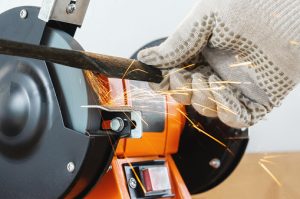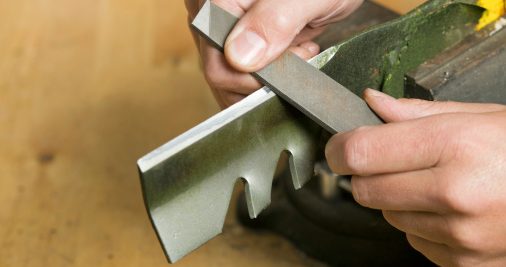If there’s one simple thing I can tell beginner gardeners that would almost certainly improve the look and health of their lawn, it is making sure your Flymo lawnmower blades are sharp before trying to cut the grass.
This simple, yet often neglected, bit of maintenance can make a real difference to the overall appearance of your grass, so don’t you think it’s time you started doing it?
In this article, we’ll cover why, when, and how to sharpen your lawn mower blades on a Flymo, but this applies to all other brands too, such as Makita, Bosch, Black & Decker, etc.
Why you should sharpen your Flymo lawnmower blades
You may be asking why sharpening your lawn mower blades is important. After all, you’ve been getting along just fine without doing it so far right?

Well, here’s the thing. While having dull blades will not necessarily prevent you from mowing the lawn, and in most cases it won’t, it WILL prevent you from ‘cutting’ the grass. Let me clarify what I mean: With dull blades, you aren’t really cutting the grass, you are ripping through it. And why is this a bad thing? Well, it’s because ripped or torn grass not only starts to turn brown and makes your lawn look dried out, it is also more susceptible to certain lawn diseases.
Conversely, grass cut with nice sharp blades recovers much faster and this helps it to stay healthy and fight for its place against other unwanted grasses and weeds.
Sharpening the lawnmower blades on your Flymo has the added benefit of making the task much easier on the motor, thus prolonging the working life of your favourite mower and saving you a few quid and a trip to the shops in the process.
Other lawnmower articles
Best lawn mower
When to sharpen the lawnmower blades on your Flymo
As a rule of thumb, sharpening your lawnmower blade 3-4 times per year is usually enough, but if you have debris in your lawn, such as stones, and your blade is hitting them you’ll need to sharpen them again after the collision. People with larger patches of grass to cut might want to sharpen them more often than this, say once a month, just to be on the safe side. If you’re really not sure if your lawnmower blades need sharpening, just take a look at them. A healthy blade will be free of chips, dents, bends, etc. and these are easy to see with the naked eye.
How sharp should the blade be?
For safety reasons, it might not be a good idea to put an edge on your lawn mower blade that you would usually see in a samurai movie, but it still needs to be sharp enough to leave a nice clean cut on your grass. I tend to sharpen mine until I know it would cut me if I ran my thumb across the edge, but not slice too deep if I accidentally brushed it. Think of somewhere between a butter knife and a steak knife.
How to sharpen lawnmower blades on a Flymo
The first thing to do is to make sure there is no chance whatsoever of the machine starting up while you are working on it, so disconnect it from any power source, and also remove the spark plug just to be on the safe side.

Make sure you’re wearing proper protective equipment, especially a pair of decent gloves and some eye protectors. You’d be surprised how many eye injuries are caused by tiny bits of debris flying out when people are changing or sharpening lawnmower blades.
The best way to remove the blades on your Flymo is to stand it on its side, a s this will give easy access to it. For electric motors, it’s not important which way up the motor sits as long as the lawnmower is on its side.
However, with petrol lawnmowers you need to be a bit more careful and ensure that the air filter and carburettor are facing upwards or you could end up with engine oil spilling into these parts and causing all sorts of problems.
Alternatively, you could drain the mower of petrol and oil first, or run the mower until both of these run out.
